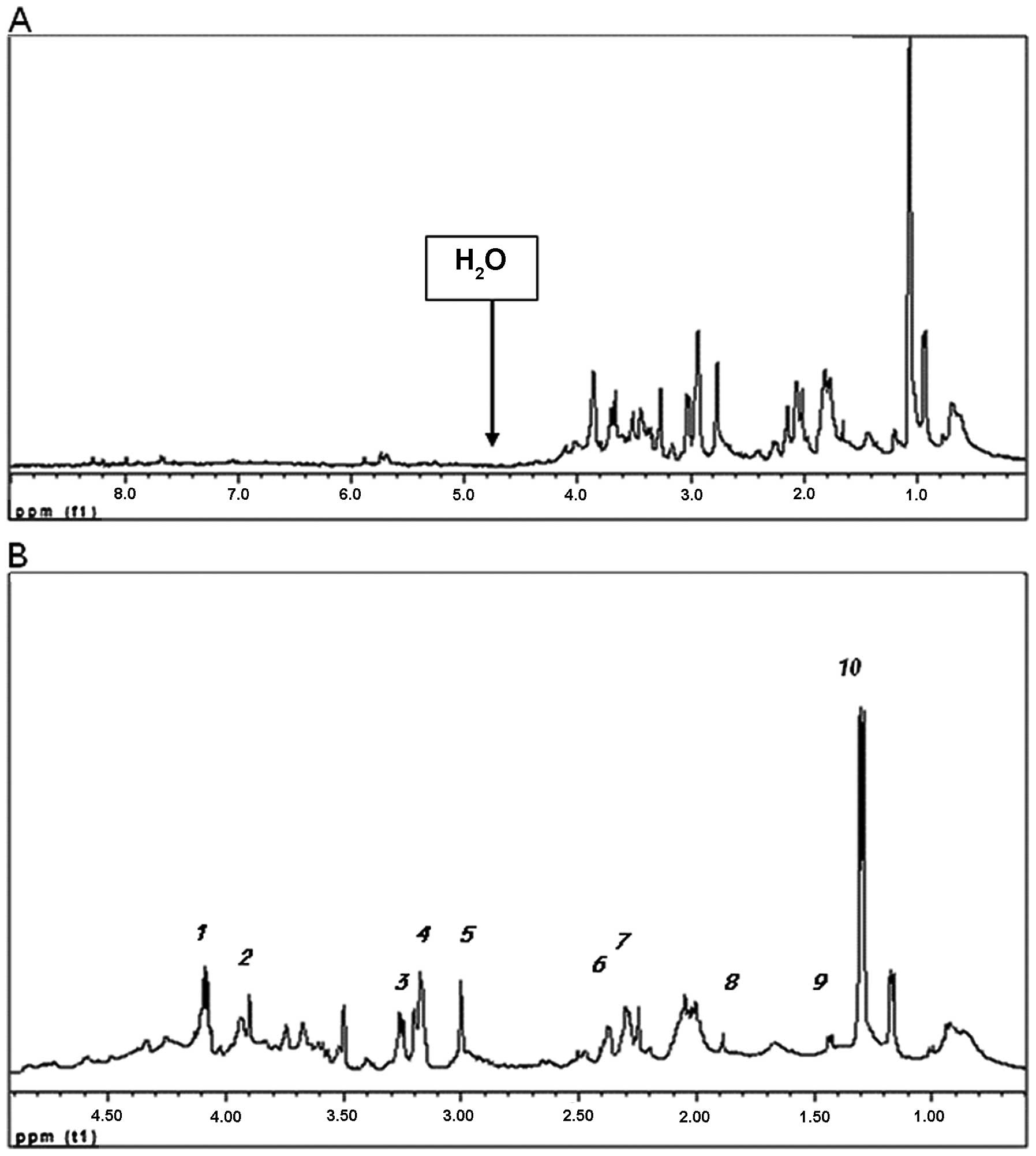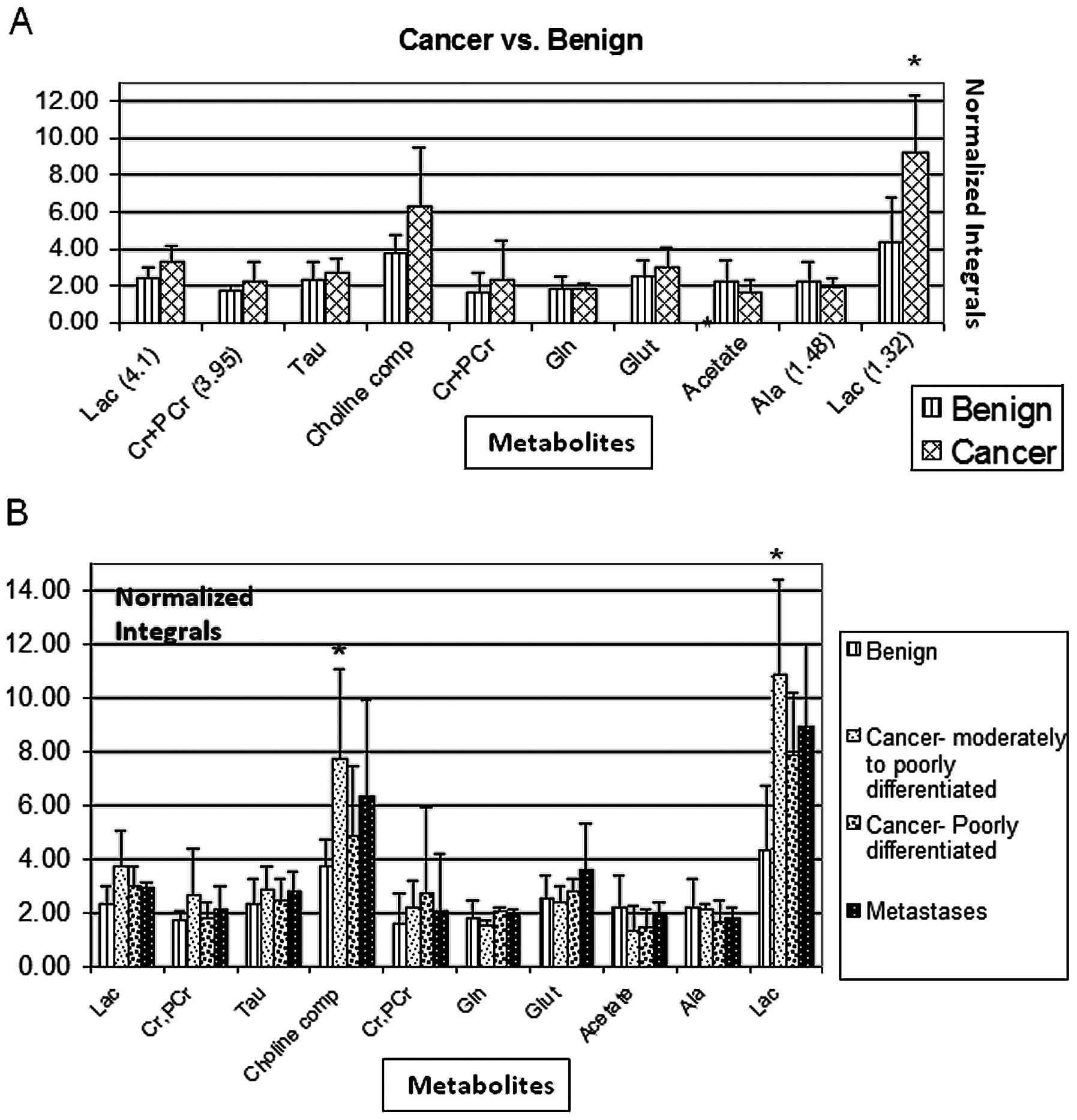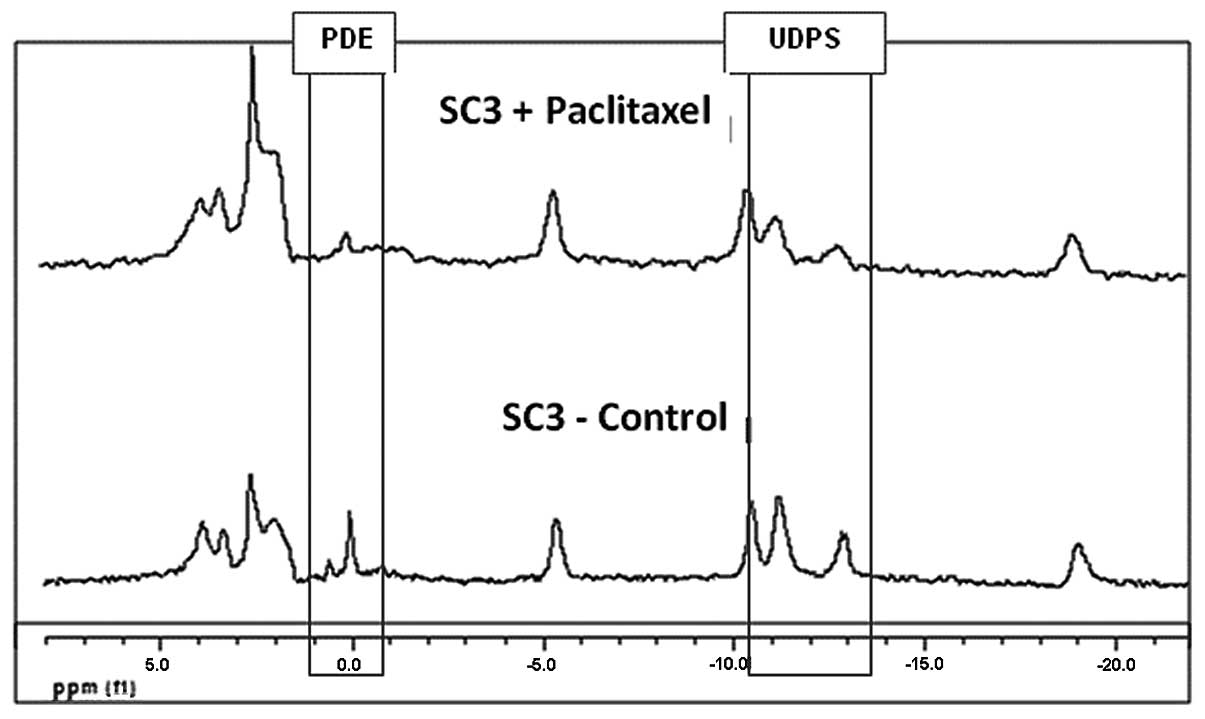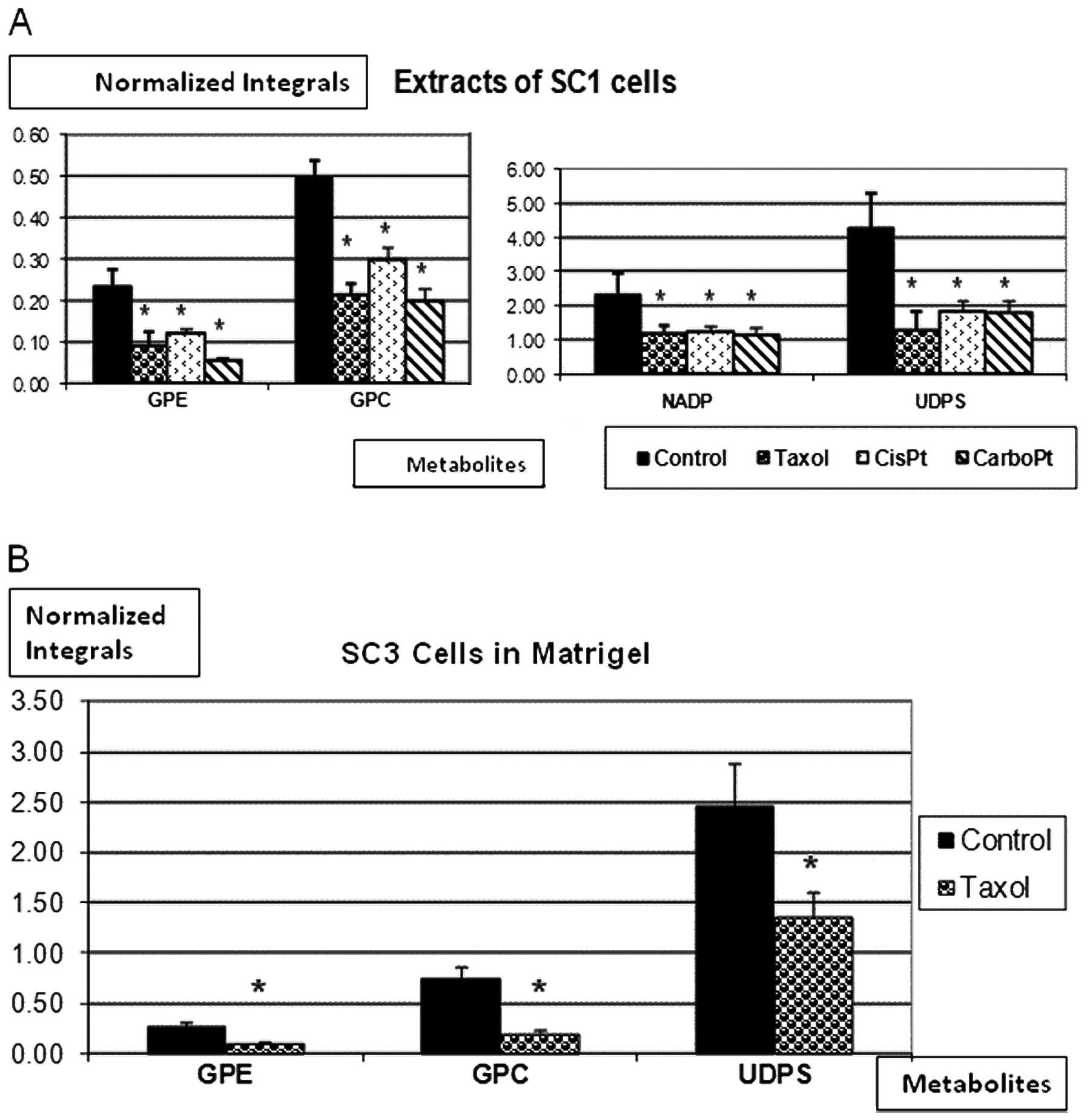|
1
|
National Cancer Institute. http://www.cancer.gov.
|
|
2
|
Jemal A, Siegel R, Ward E, Hao Y, Xu J and
Thun MJ: Cancer statistics 2009. CA Cancer J Clin. 59:225–249.
2009. View Article : Google Scholar
|
|
3
|
Tennant DA, Durán RV, Boulahbel H and
Gottlieb E: Metabolic transformation in cancer. Carcinogenesis.
30:1269–1280. 2009. View Article : Google Scholar : PubMed/NCBI
|
|
4
|
Vander Heiden MG, Cantley LC and Thompson
CB: Understanding the Warburg effect: the metabolic requirements of
cell proliferation. Science. 324:1029–1033. 2009.PubMed/NCBI
|
|
5
|
Wise DR, DeBerardinis RJ, Mancuso A, et
al: Myc regulates a transcriptional program that stimulates
mitochondrial glutaminolysis and leads to glutamine addiction. Proc
Natl Acad Sci USA. 105:18782–18787. 2008. View Article : Google Scholar : PubMed/NCBI
|
|
6
|
Zupke C and Foy B: Nuclear magnetic
resonance analysis of cell metabolism. Curr Opin Biotechnol.
6:192–197. 1995. View Article : Google Scholar : PubMed/NCBI
|
|
7
|
Bel JD and Bhakoo KK: Metabolic changes
underlying 31P MR spectral alterations in human hepatic
tumours. NMR Biomed. 11:354–359. 1998.
|
|
8
|
Sterin M, Cohen JS, Mardor Y, Berman E and
Ringel I: Levels of phospholipid metabolites in breast cancer cells
treated with antimitotic drugs: a 31P-magnetic resonance
spectroscopy study. Cancer Res. 61:7536–7543. 2001.PubMed/NCBI
|
|
9
|
Massuger LF, van Vierzen PBJ, Engelke U,
Heerschap A and Wevers RA: 1H-magnetic resonance
spectroscopy: a new technique to discriminate benign from malignant
ovarian tumors. Cancer. 82:1726–1730. 1998. View Article : Google Scholar : PubMed/NCBI
|
|
10
|
Boss EA, Moolenaar SH, Massuger LFAG,
Boonstra H, Engelke UFH, de Jong JGN and Wevers RA: High-resolution
proton nuclear magnetic resonance spectroscopy of ovarian cyst
fluid. NMR Biomed. 13:297–305. 2000. View Article : Google Scholar : PubMed/NCBI
|
|
11
|
Podo F: Tumour phospholipid metabolism.
NMR Biomed. 12:413–439. 1999. View Article : Google Scholar : PubMed/NCBI
|
|
12
|
Tosi R and Tugnoli V: Nuclear Magnetic
Resonance Spectroscopy in the Study of Neoplastic Tissue. Nova
Science Publishers Inc.; New York, NY: pp. 1–444. 2005
|
|
13
|
Gillies RJ and Morse DL: In vivo magnetic
resonance spectroscopy in cancer. Annu Rev Biomed Eng. 7:287–326.
2005. View Article : Google Scholar : PubMed/NCBI
|
|
14
|
Kwock L, Smith JK, Castillo M, et al:
Clinical role of proton magnetic resonance spectroscopy in
oncology: brain, breast, and prostate cancer. Lancet Oncol.
7:859–868. 2006. View Article : Google Scholar : PubMed/NCBI
|
|
15
|
Mackinnon WB, Russell P, May GL and
Mountford CE: Characterization of human ovarian epithelial tumors
(ex vivo) by proton magnetic resonance spectroscopy. Int J Gynecol
Cancer. 5:211–221. 1995. View Article : Google Scholar : PubMed/NCBI
|
|
16
|
Wallace JC, Raaphorst GP, Somorjai RL, et
al: Classification of 1H MR spectra of biopsies from
untreated and recurrent ovarian cancer using linear discriminant
analysis. Magn Reson Med. 38:569–576. 1997.
|
|
17
|
Slupsky CM, Steed H, Wells TH, et al:
Urine metabolite analysis offers potential early diagnosis of
ovarian and breast cancers. Clin Cancer Res. 16:5835–5841. 2010.
View Article : Google Scholar : PubMed/NCBI
|
|
18
|
Podo F, Canevari S, Canese R, Pisanu ME,
Ricci A and Iorio E: MR evaluation of response to targeted
treatment in cancer cells. NMR Biomed. 24:648–672. 2011.PubMed/NCBI
|
|
19
|
Katz-Brull R, Lavin PT and Lenkinski RE:
Clinical utility of proton magnetic resonance spectroscopy in
characterizing breast lesions. J Natl Cancer Inst. 94:1197–1203.
2002. View Article : Google Scholar : PubMed/NCBI
|
|
20
|
Aboagye EO and Bhujwalla ZM: Malignant
transformation alters membrane choline phospholipid metabolism of
human mammary epithelial cells. Cancer Res. 59:80–84. 1999.
|
|
21
|
Glunde K, Jie C and Bhujwalla M: Molecular
causes of the aberrant choline phospholipid metabolism in breast
cancer. Cancer Res. 64:4270–4276. 2004. View Article : Google Scholar : PubMed/NCBI
|
|
22
|
Glunde K, Ackerstaff E, Natarajan K,
Artemov D and Bhujwalla ZM: Real-time changes in 1H and
31P NMR spectra of malignant human mammary epithelial
cells during treatment with the anti-inflammatory agent
indomethacin. Magn Reson Med. 48:819–825. 2002.
|
|
23
|
Ackerstaff E, Pflug BR, Nelson JB and
Bhujwalla ZM: Detection of increased choline compounds with proton
nuclear magnetic resonance spectroscopy subsequent to malignant
transformation of human prostatic epithelial cells. Cancer Res.
61:3599–3603. 2001.
|
|
24
|
Iorio E, Mezzanzanica D, Alberti P, et al:
Alterations of choline phospholipid metabolism in ovarian tumor
progression. Cancer Res. 65:9369–9376. 2005. View Article : Google Scholar : PubMed/NCBI
|
|
25
|
Canese R, PIsanu ME, Mezzanzanica D, et
al: Characterisation of in vivo ovarian cancer models by
quantitative 1H magnetic resonance spectroscopy and
diffusion-weighted imaging. NMR Biomed. 25:632–642. 2012.PubMed/NCBI
|
|
26
|
Esseridou A, Di Leo G, Sconfienza LM, et
al: In vivo detection of choline in ovarian tumors using 3D
magnetic resonance spectroscopy. Invest Radiol. 46:377–382. 2011.
View Article : Google Scholar : PubMed/NCBI
|
|
27
|
Iorio E, Ricci A, Bagnoli M, Pisanu ME, et
al: Activation of phosphtidylcholine cycle enzymes in human
epithelial ovarian cancer cells. Cancer Res. 70:2126–2135. 2010.
View Article : Google Scholar : PubMed/NCBI
|
|
28
|
Cheng LL, Chang IW, Smith BL and Gonzalez
RG: Evaluating human breast ductal carcinomas with high-resolution
magic-angle spinning proton magnetic resonance spectroscopy. J Magn
Reson. 135:194–202. 1998. View Article : Google Scholar
|
|
29
|
Tessem MB, Swanson MG, Keshari KR, et al:
Evaluation of lactate and alanine as metabolic biomarkers of
prostate cancer using 1H HR-MAS spectroscopy of biopsy
tissues. Magn Reson Med. 60:510–516. 2008. View Article : Google Scholar : PubMed/NCBI
|
|
30
|
Brizel DM, Schroeder T, Scher RL, Walenta
S, Clough RW, Dewhirst MW and Mueller-Klieser W: Elevated tumor
lactate concentrations predict for an increased risk of metastases
in head-and-neck cancer. Int J Radiat Oncol Biol Phys. 51:349–353.
2001. View Article : Google Scholar : PubMed/NCBI
|
|
31
|
Walenta S, Wetterling M, Lehrke M,
Schwickert G, Sundfor K, Rofstad EK and Mueller-Klieser W: High
lactate levels predict likelihood of metastases, tumor recurrence,
and restricted patient survival in human cervical cancers. Cancer
Res. 60:916–921. 2000.
|
|
32
|
Huang Z, Tong Y, Wang J and Huang Y: NMR
studies of the relationship between the changes of membrane lipids
and the cisplatin resistance of A549/DDP cells. Cancer Cell Int.
3:52003. View Article : Google Scholar : PubMed/NCBI
|
|
33
|
Hanauske AR, Depenbrock H, Shirvani D and
Rastetter J: Effects of the microtubule-disturbing agents docetaxel
(Taxotere), vinblastine and vincristine on epidermal growth
factor-receptor binding of human breast cancer cell lines in vitro.
Eur J Cancer. 30A:1688–1694. 1994. View Article : Google Scholar
|
|
34
|
Chahine JMEH, Cribier S and Devaux PF:
Phospholipid transmembrane domains and lateral diffusion in
fibroblasts. Proc Natl Acad Sci USA. 90:447–451. 1993. View Article : Google Scholar : PubMed/NCBI
|
|
35
|
Pike MC, Kredich NM and Snyderman R:
Influence of cytoskeletal assembly on phosphatidylcholine synthesis
in intact phagocytic cells. Cell. 20:373–379. 1980. View Article : Google Scholar : PubMed/NCBI
|
|
36
|
Fallbrook A, Turenne SD, Mamalias N, Kish
SJ and Ross BM: Phosphatidylcholine and phosphatidylethanolamine
metabolites may regulate brain phospholipid catabolism via
inhibition of lysophospholipase activity. Brain Res. 834:207–210.
1999. View Article : Google Scholar
|


















